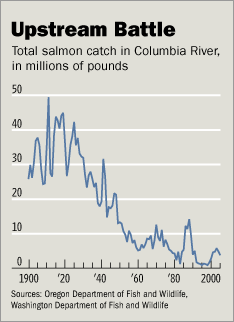forum
library
tutorial
contact

Upstream Battle to Save the Salmon
by Jeff CurtisWall Street Journal, October 4, 2006
|
the film forum library tutorial contact |

|
Upstream Battle to Save the Salmonby Jeff CurtisWall Street Journal, October 4, 2006 |
Two Points of View
 Your recent article "Inside the Failure of $8 Billion Effort to Save Prized Fish
" (page one, Sept. 19), describing efforts to recover threatened and endangered Pacific Northwest salmon, makes clear what an enormously complex task we have in rebuilding fish populations. From the perspective of the federal agencies with key roles in achieving recovery of these fish, the region has made very positive strides and steady progress over the past 25 years. Between 2001 and 2004, we have seen substantial increases in 11 of 13 Columbia Basin salmon and steelhead listed as threatened or endangered. In addition, the past five years have seen the highest returns of spring, summer and fall chinook salmon since we began record-keeping more than 60 years ago.
Your recent article "Inside the Failure of $8 Billion Effort to Save Prized Fish
" (page one, Sept. 19), describing efforts to recover threatened and endangered Pacific Northwest salmon, makes clear what an enormously complex task we have in rebuilding fish populations. From the perspective of the federal agencies with key roles in achieving recovery of these fish, the region has made very positive strides and steady progress over the past 25 years. Between 2001 and 2004, we have seen substantial increases in 11 of 13 Columbia Basin salmon and steelhead listed as threatened or endangered. In addition, the past five years have seen the highest returns of spring, summer and fall chinook salmon since we began record-keeping more than 60 years ago.
While ocean conditions have a tremendous influence on salmon populations, a great deal of credit also goes to improvements that provide safer and quicker salmon passage at Columbia and Snake River dams, improvements in spawning and rearing habitat, predator control and improved hatchery and harvest management. These programs are designed and carried out by a multitude of federal agencies, states, local governments and tribes throughout the Pacific Northwest.
Today, adult salmon and steelhead passing upriver through the eight-dam Columbia and Snake River hydro system survive at levels equivalent to pre-dam conditions. And juvenile salmon passing downriver through the dams are moving more quickly and safely because of new fish passage devices we've installed at two lower Snake River dams and one dam on the Columbia River. More dams are scheduled to receive similar devices. Our job isn't done, but tremendous progress has been made.
Bob Lohn, Northwest Regional Director, NOAA Fisheries,Seattle
(The letter is also signed by Karen Durham-Aguilera, director of Programs, Northwestern Division, U.S. Army Corps of Engineers, and Steve Wright, administrator, Bonneville Power Administration, Portland, Ore.)
Your article is right about the failure of the Bonneville Power Administration to restore Northwest salmon, but it's misleading about the causes for the decline and the reasons Bonneville has failed. Rather than make the difficult decisions that scientists say have the greatest likelihood of success, Bonneville has instead relied on half-hearted, over-engineered fixes that never get to the root of the problem, which is that the salmon no longer have a living river to traverse in their journeys to and from the Pacific Ocean. For Snake River salmon, eight dams, including four dams on the lower Snake River, and eight slack-water reservoirs stand between their spawning grounds in Idaho and the ocean.
On top of that, almost 80% of the juvenile salmon begin their lives in hatcheries and prepare for their epic journey by swimming endless circles in concrete raceways.
If there is a model for restoring salmon, it is the last remaining free-flowing undammed stretch of the Columbia River that flows past the Hanford Nuclear Reservation. Above four (Columbia River) dams, it nevertheless supports a strong run of wild chinook salmon that are caught in significant numbers by fishermen from Alaska to the Columbia River itself.
Scientists overwhelmingly tell us that breaching the four lower Snake River dams and focusing on wild salmon instead of inferior hatchery fish are the answers to restoring the once great salmon runs. Unfortunately, lack of vision and political courage continue to result in billions more wasted on ever more complex engineering fixes and hi-tech fish tracking gizmos, which sadly serve mainly to chronicle the slow decline of these magnificent fish toward extinction.
learn more on topics covered in the film
see the video
read the script
learn the songs
discussion forum
